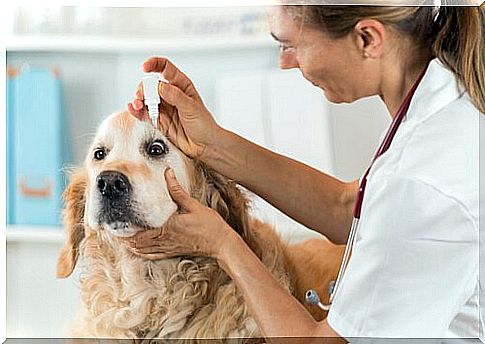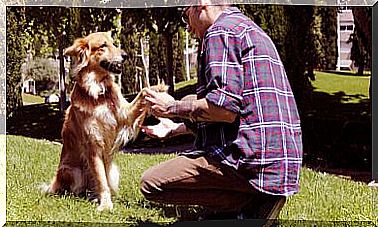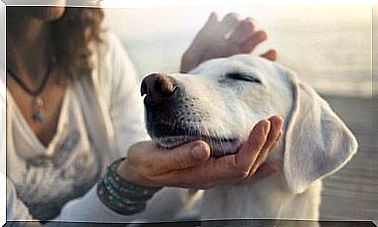What Causes Your Dog To Tear Up?

The only human beings who cry to express an emotion are human beings. Your dog’s tearing can be rife, but that doesn’t mean the tears are a reflection of anything other than a simple physiological response. Sometimes it’s not even indicative of something wrong with the pet.
Emotions in dogs
“Man’s best friend” doesn’t cry with sadness or joy, but that doesn’t mean he isn’t able to express emotions. In fact, they tend to externalize their feelings unambiguously.
Dogs can use howls to show sadness, loneliness, pain and sometimes joy. They moan when something hurts them physically or is uncomfortable. They bark out of happiness, out of fear or when they’re upset.
Frantic tail movements are almost always related to maximum happiness, although they can also occasionally be indicative of anxiety.
Like humans, when animals don’t eat and simply get up, it’s a sign of depression and sadness . Through their eyes they also show the world not only their emotions, but also their true state of mind. They have tears or not, but they are unable to hide sadness or happiness in their eyes.
Lacrimejo: the first line of defense for the eyeballs
The main function of tearing in your dog is to protect the eyes and keep them hydrated. Also, it fulfills the task of expelling any foreign element that lodges in the surroundings or in the eyeball.
Very drastic weather variations and very strong drafts are other triggers. When these specific cases are presented, far from being considered a medical problem, it is a sign that the ocular defenses are functioning well.
Peculiarities of each race
It should also be taken into account that some breeds, due to their own characteristics, tend to have more tearing. On this list are those with big eyes compared to the size of their head, like Chihuahuas and the Shih Tzu. Also those with a lot of fur near the eyes, such as poodles and maltese bichon.

When your dog’s tearing isn’t right
When tears are excessive and constant, and are more than just a clear liquid, it ‘s time to visit the veterinarian for the relevant evaluation. These episodes can originate for several reasons:
Eye injuries or presence of foreign objects
Unlike emotions, when tears obey the presence of a foreign element, such as a speck of dust, the liquid’s function is similar in dogs and humans. The same happens when the cornea is injured.
Allergies
In addition to tears, allergies are accompanied by inflammation and redness of the entire eyeball. Whiplashes will also appear, such that opening the eyes will become difficult for the animal. Other signs are sneezing and frequent coughing.
infections
These episodes are identified when, in addition to the excessive presence of tears and redness, yellowish or greenish secretions appear, also evident and abundant. Another symptom of infected eyes is irritation of the eyeball and the inner edge of the eyelids.
Conjunctivitis
Conjunctivitis in dogs can appear due to a specific problem or any problem caused by dry eyes, environmental irritation or even malformation of the eyelids. But it can also be a symptom of a more serious illness such as distemper or hepatitis.

What to do if there is a lot of tearing in your dog?
In the face of excessive tearing in your dog, accompanied by one or more of the symptoms described, the first step to take is to go to the veterinarian immediately. The specialist, after evaluating the clinical picture, will determine the origin of the problem and prescribe the appropriate treatment.
While waiting for the medical evaluation, there are some measures that can be considered. There are tips that will help your pet deal with the situation while receiving professional attention. For example:
- Rinse eyes with plenty of warm water, do not rub.
- If a wound is not felt on the cornea or eyelids, a physiological saline solution or an infusion of cold chamomile can be used along with gauze.
- Remove any elements that may be causing allergic reactions. This is the case with air fresheners and cleaning products.









